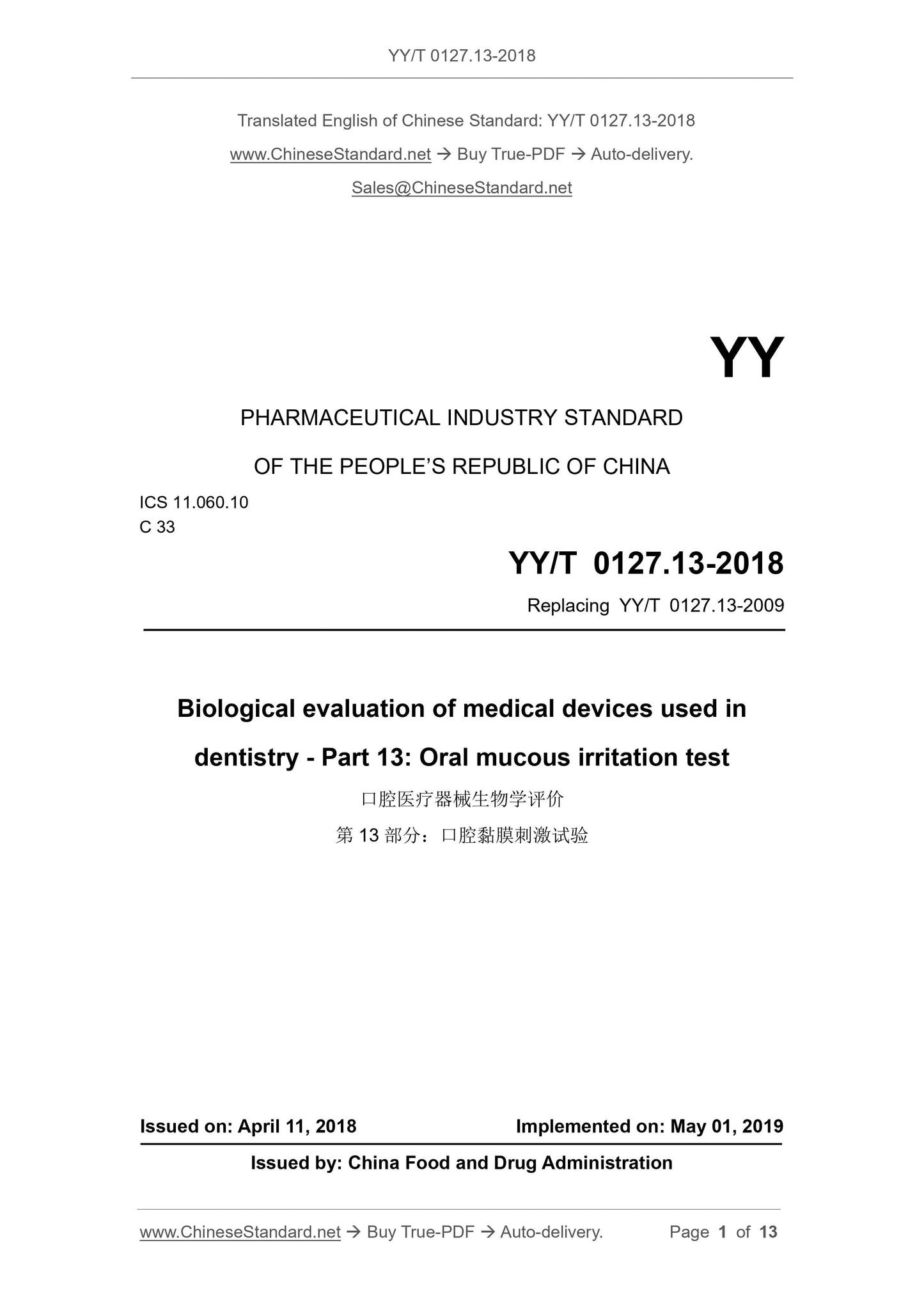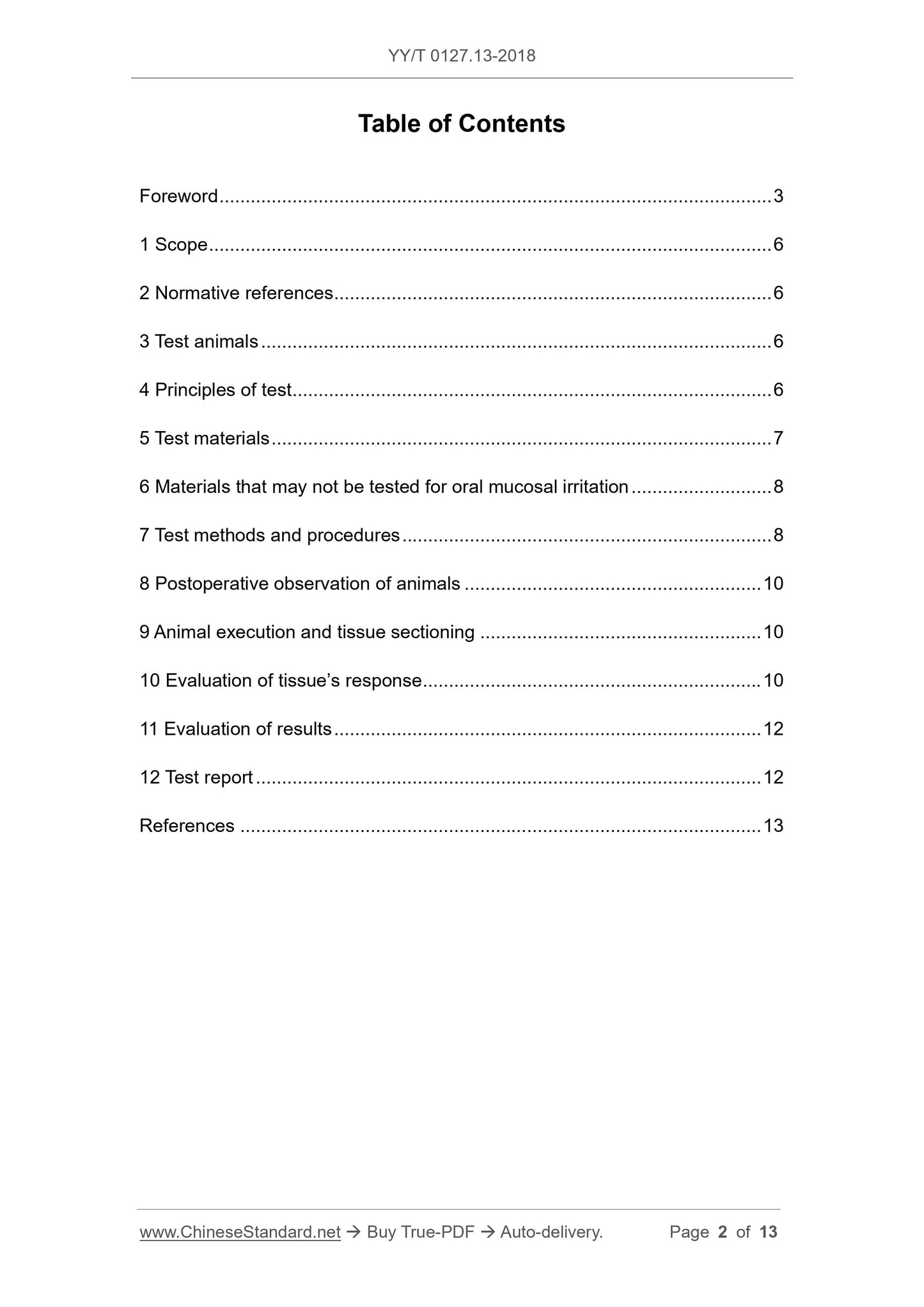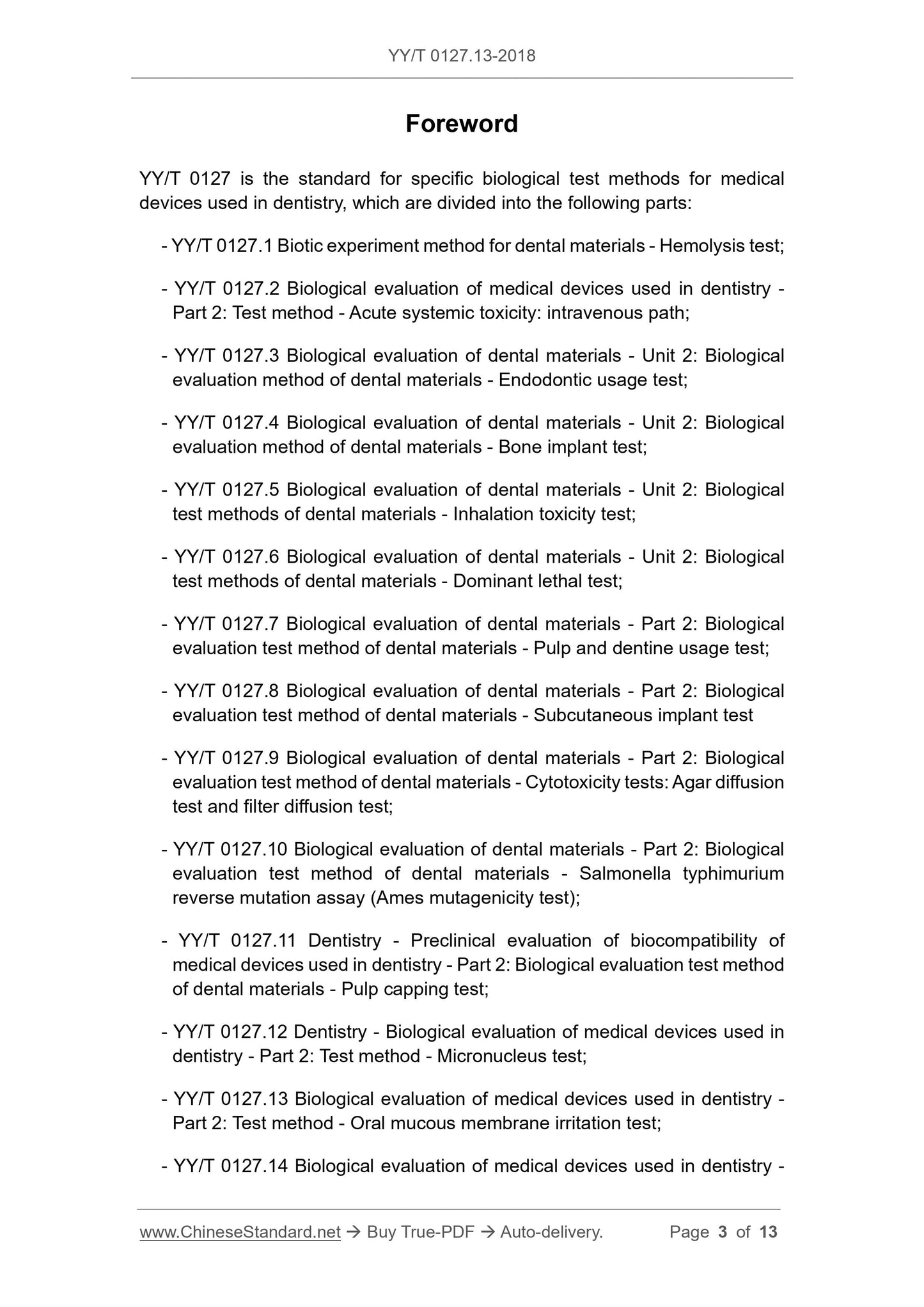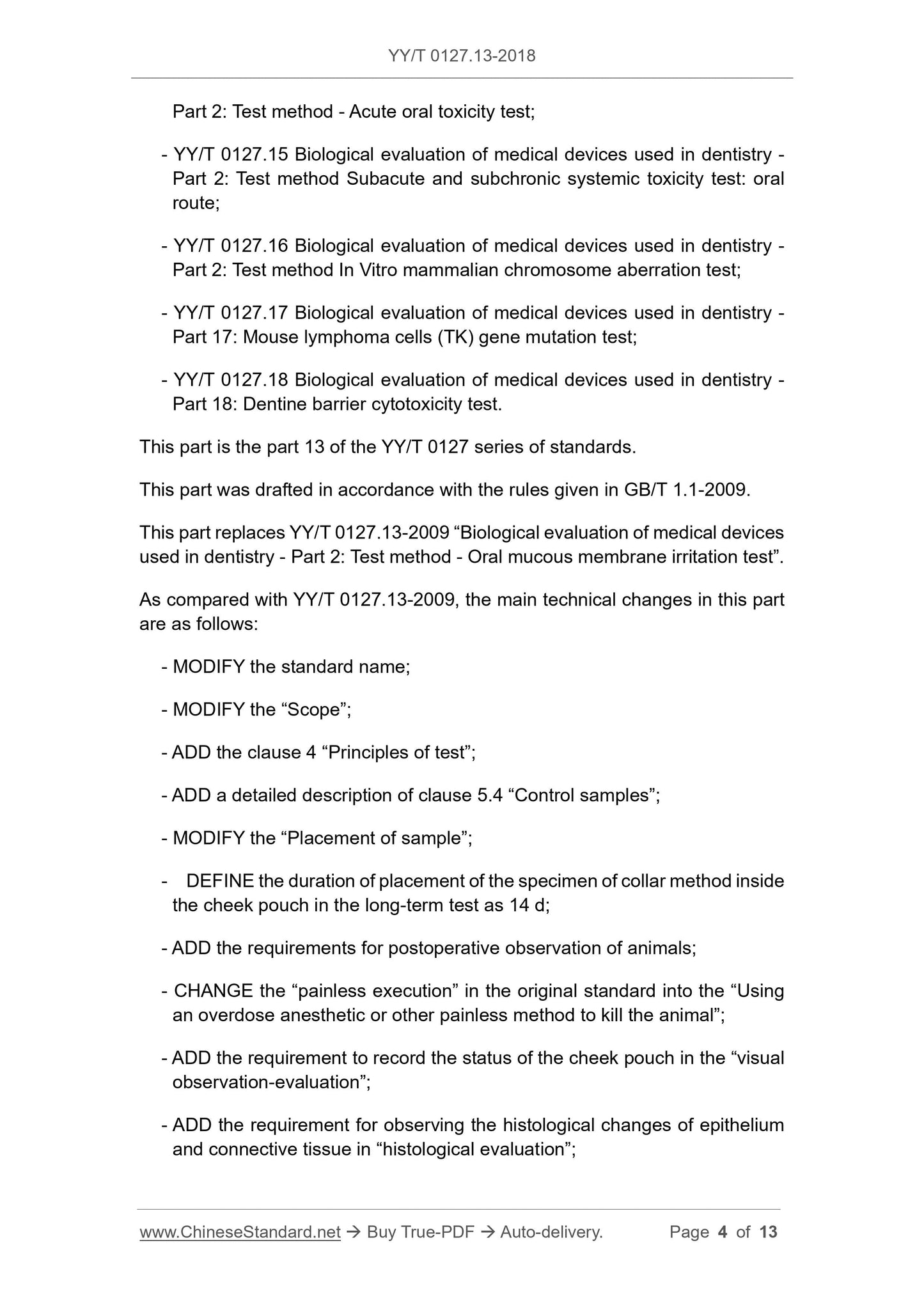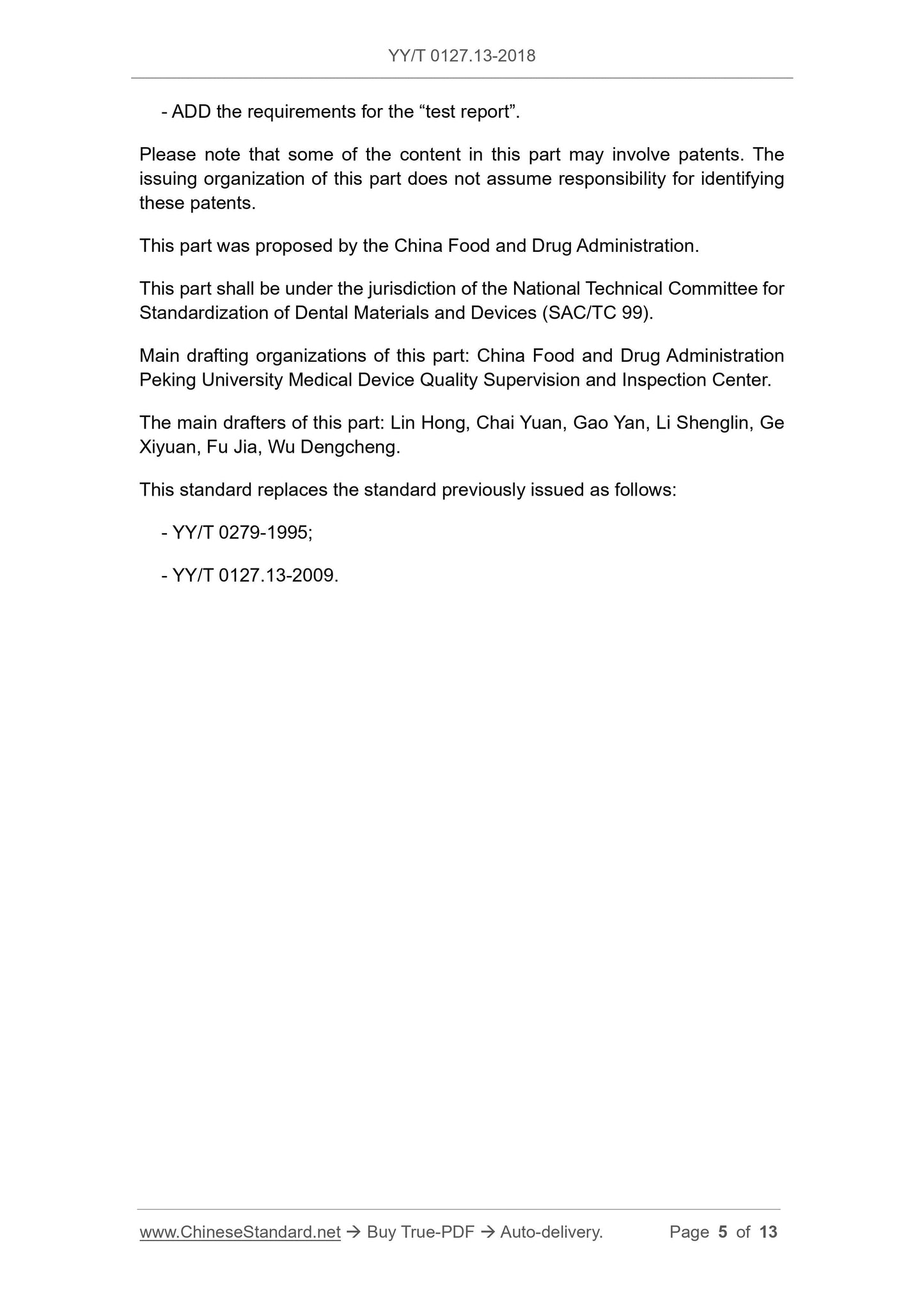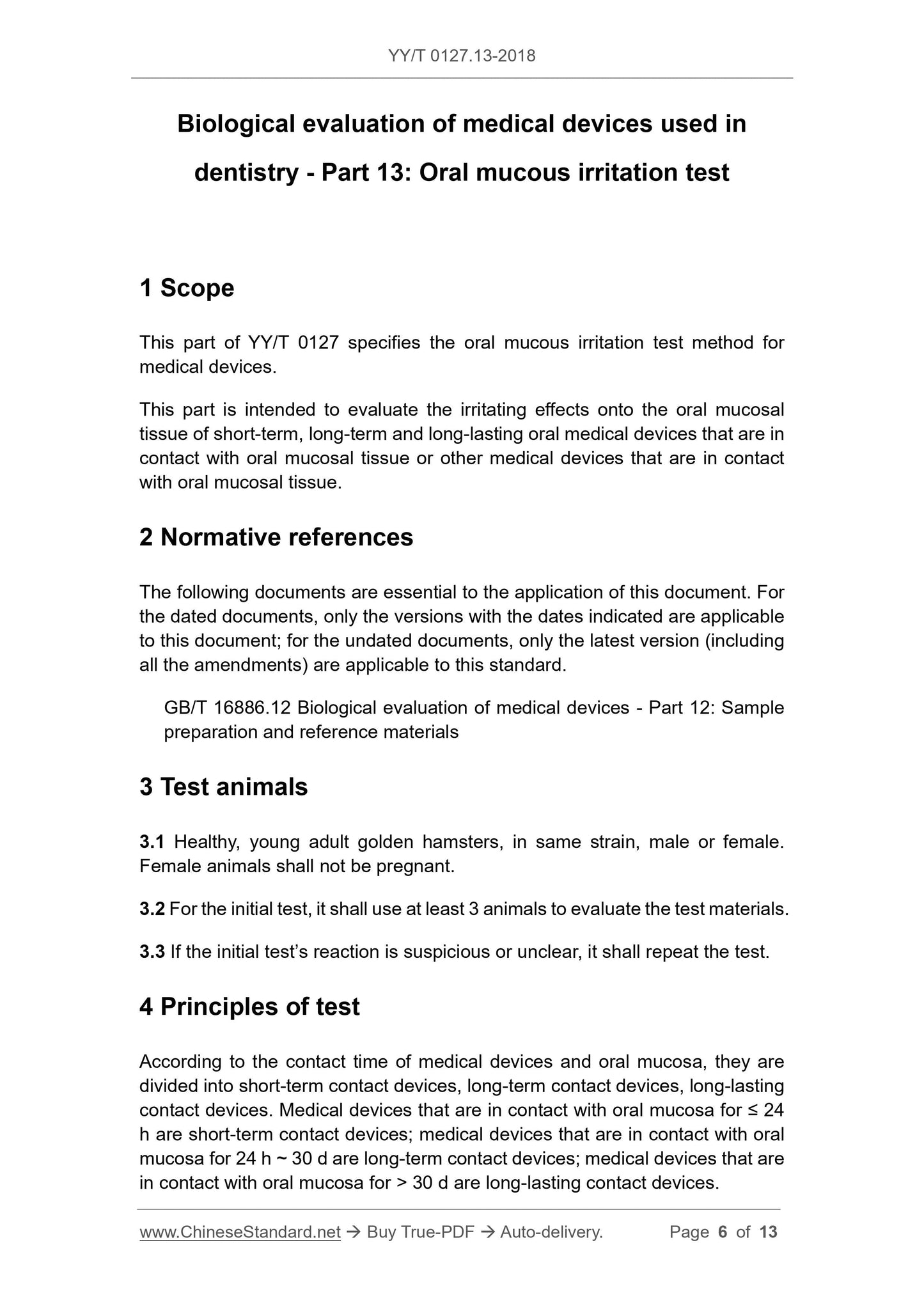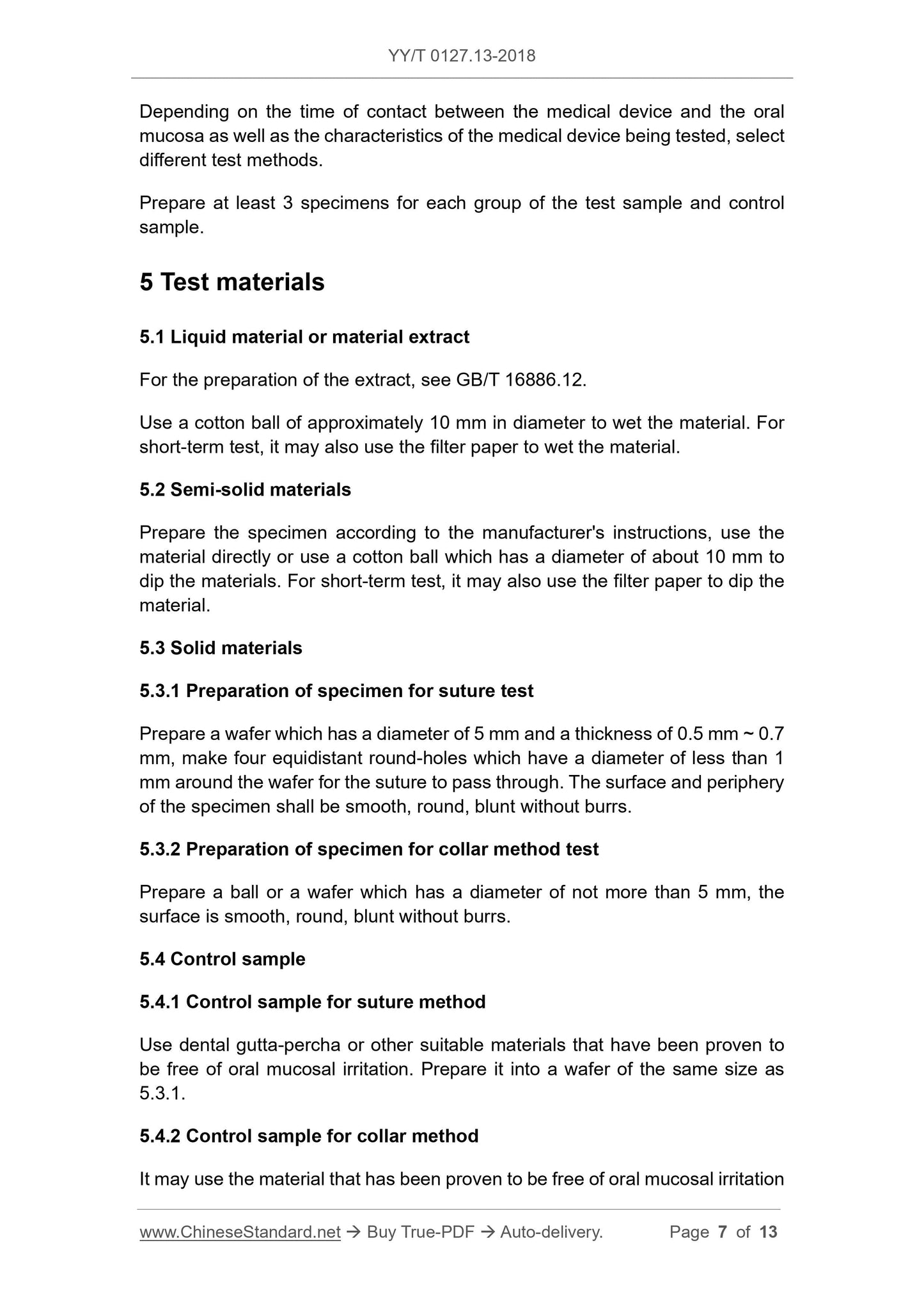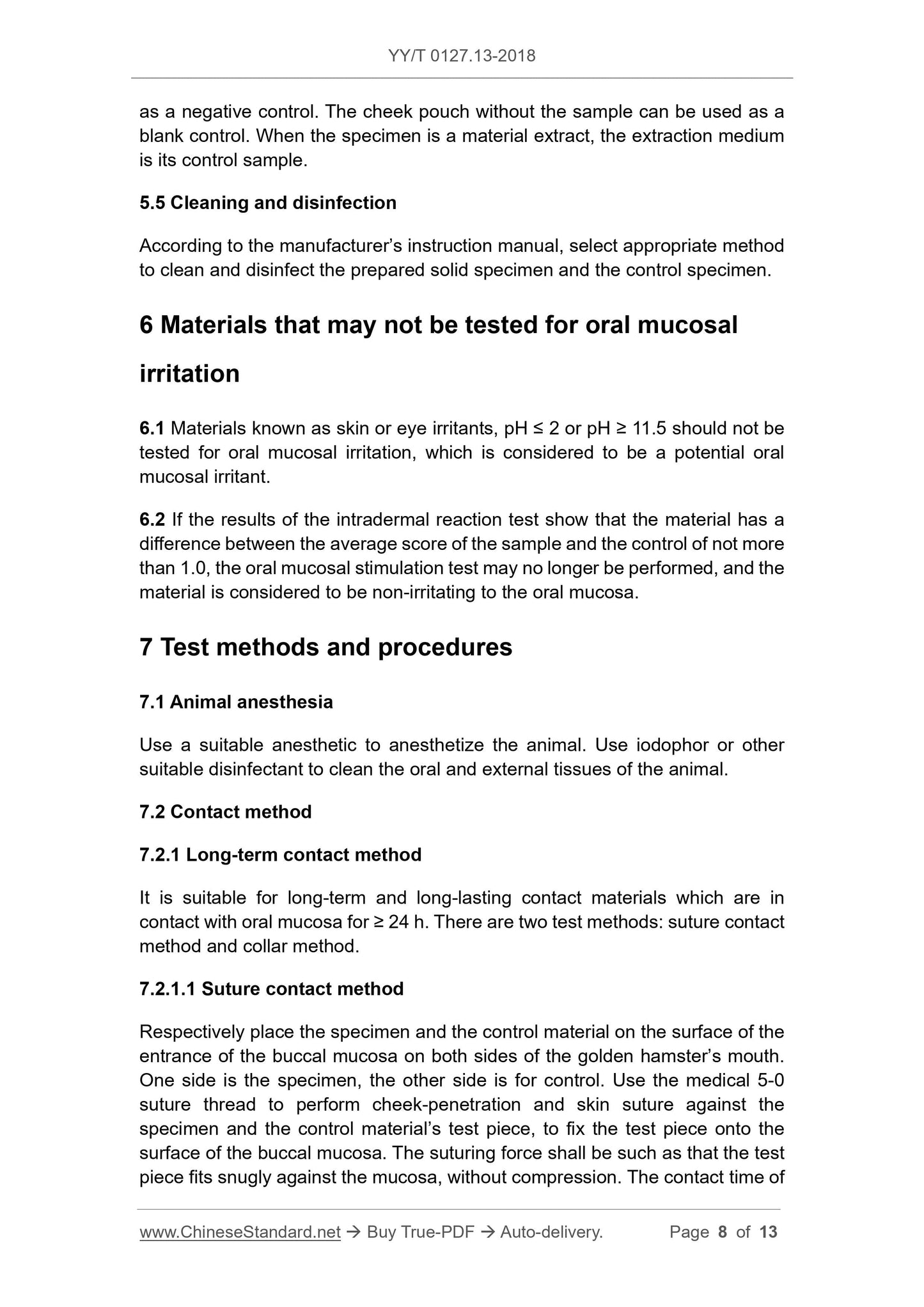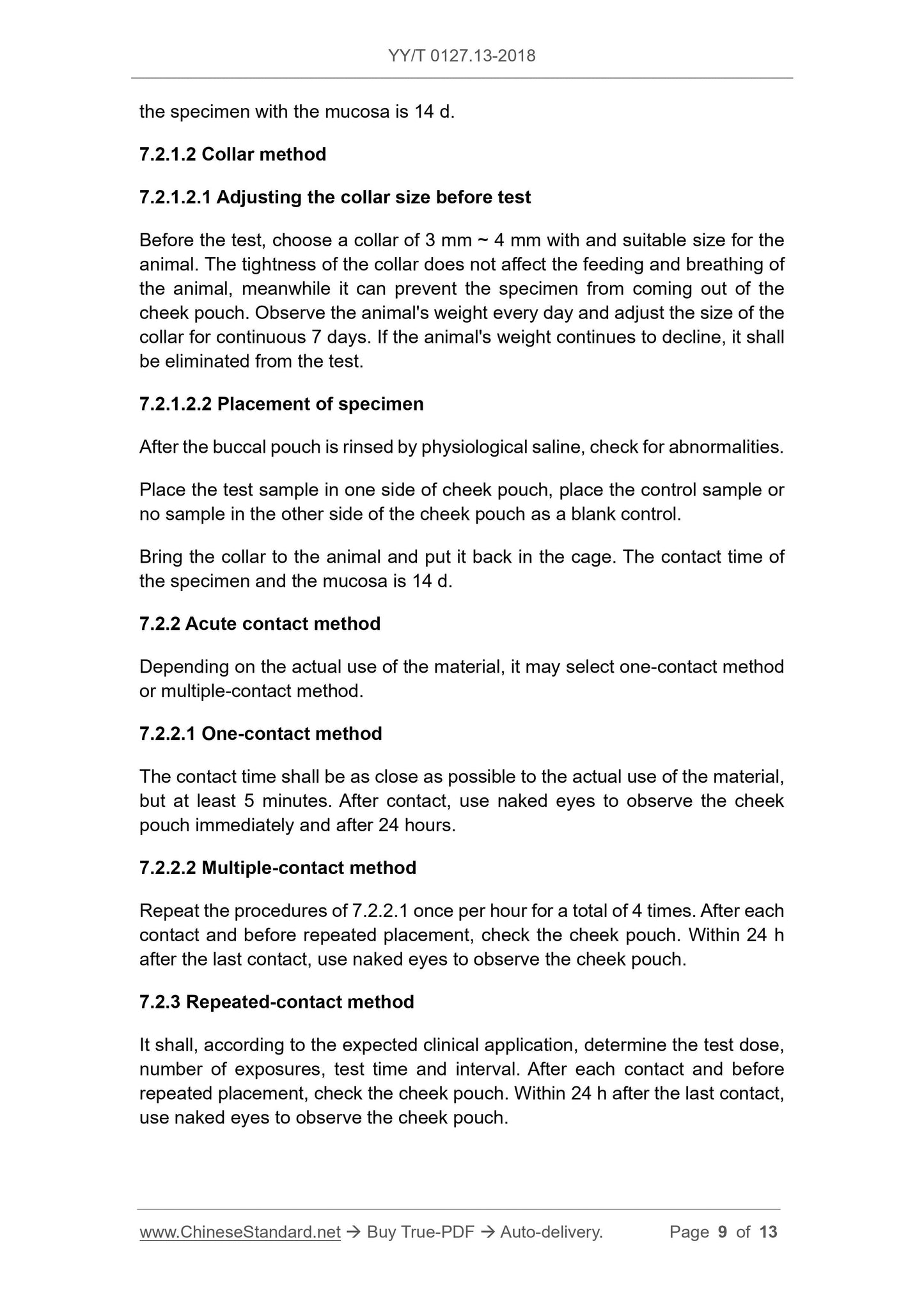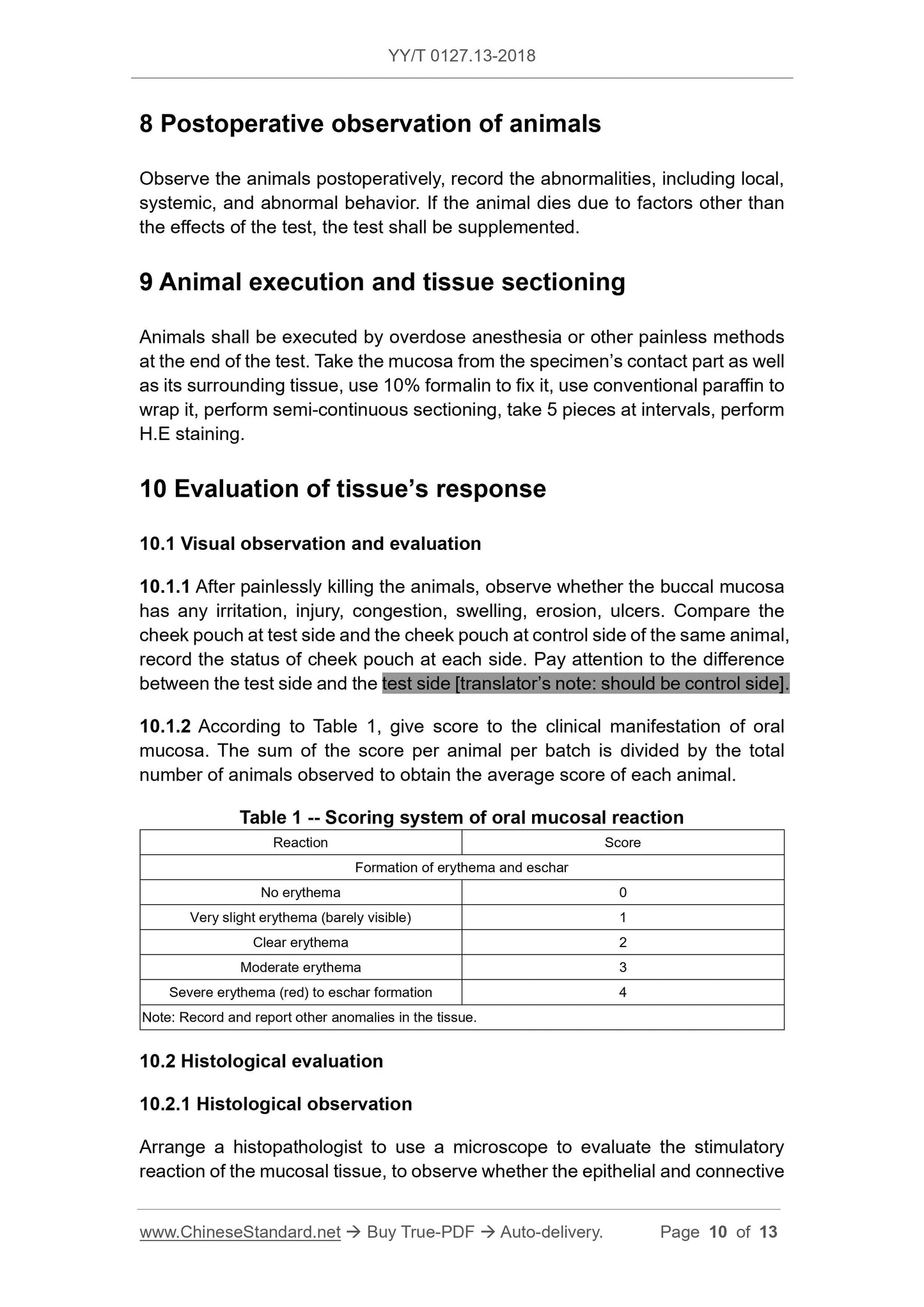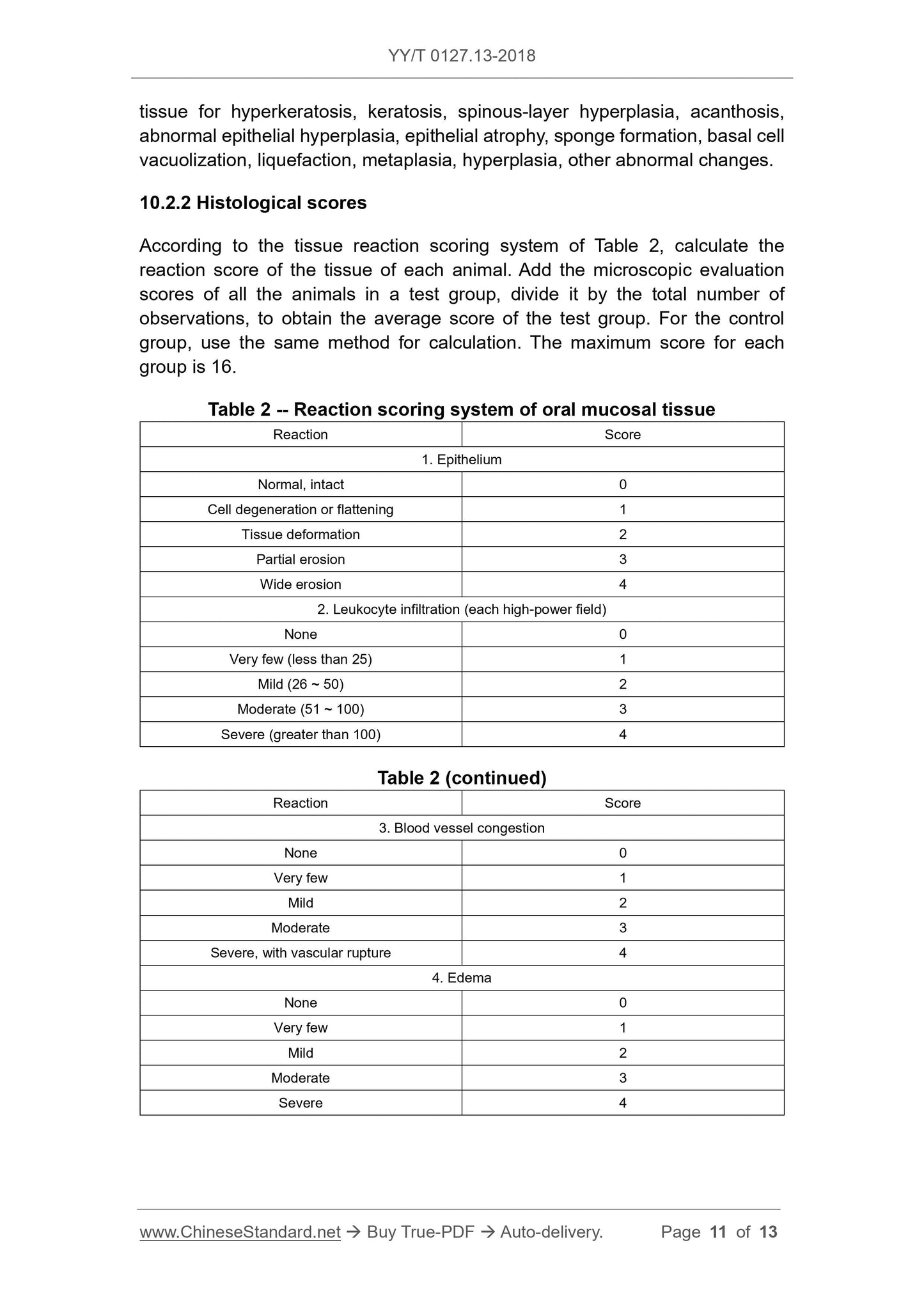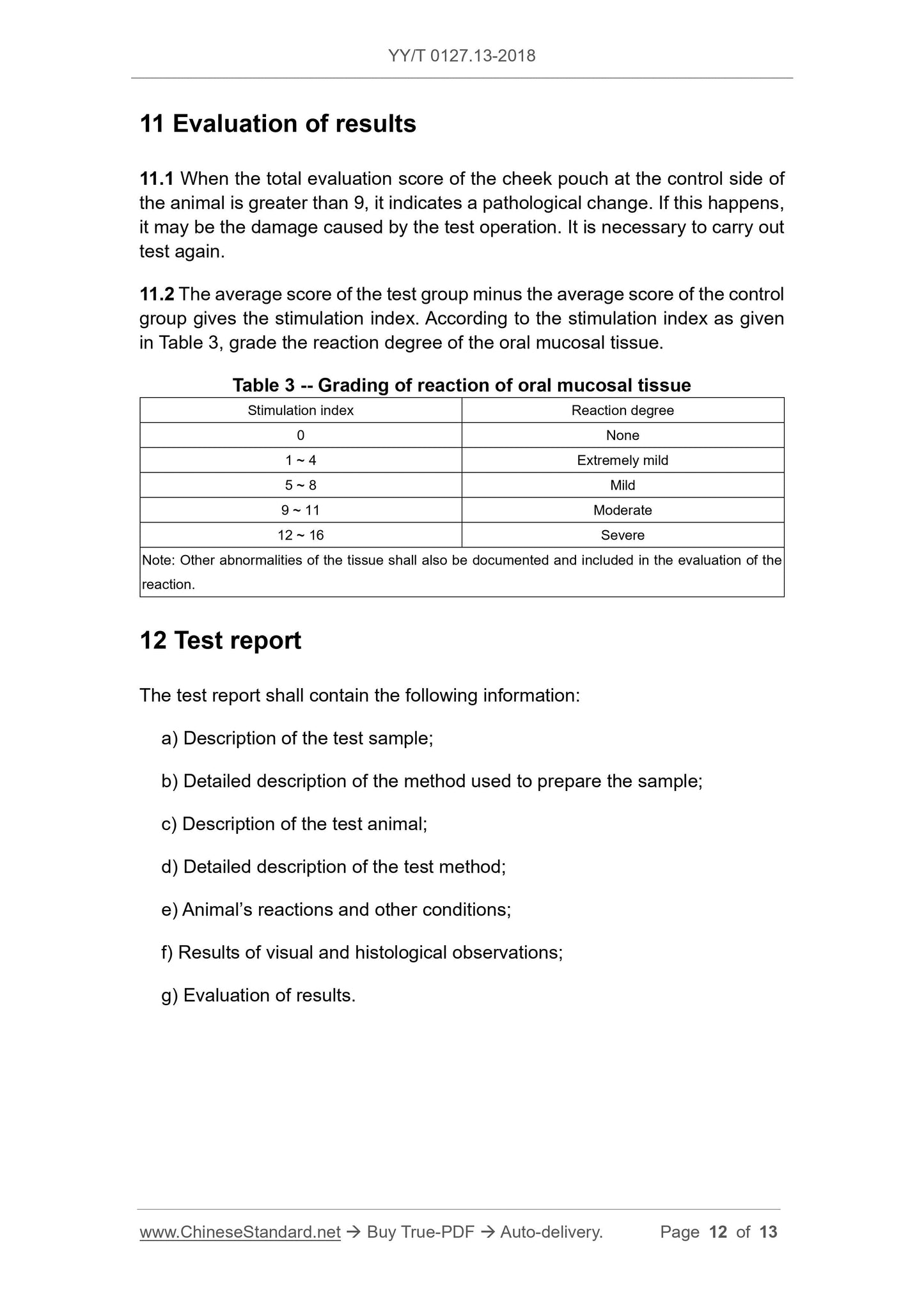1
/
von
12
PayPal, credit cards. Download editable-PDF & invoice in 1 second!
YY/T 0127.13-2018 English PDF (YYT0127.13-2018)
YY/T 0127.13-2018 English PDF (YYT0127.13-2018)
Normaler Preis
$140.00 USD
Normaler Preis
Verkaufspreis
$140.00 USD
Grundpreis
/
pro
Versand wird beim Checkout berechnet
Verfügbarkeit für Abholungen konnte nicht geladen werden
Delivery: 3 seconds. Download true-PDF + Invoice.
Get QUOTATION in 1-minute: Click YY/T 0127.13-2018
Historical versions: YY/T 0127.13-2018
Preview True-PDF (Reload/Scroll if blank)
YY/T 0127.13-2018: Biological evaluation of medical devices used in dentistry--Part 13: Oral mucous irritation test
YY/T 0127.13-2018
YY
PHARMACEUTICAL INDUSTRY STANDARD
OF THE PEOPLE’S REPUBLIC OF CHINA
ICS 11.060.10
C 33
Replacing YY/T 0127.13-2009
Biological evaluation of medical devices used in
dentistry - Part 13. Oral mucous irritation test
ISSUED ON. APRIL 11, 2018
IMPLEMENTED ON. MAY 01, 2019
Issued by. China Food and Drug Administration
Table of Contents
Foreword ... 3
1 Scope ... 6
2 Normative references ... 6
3 Test animals ... 6
4 Principles of test ... 6
5 Test materials ... 7
6 Materials that may not be tested for oral mucosal irritation ... 8
7 Test methods and procedures ... 8
8 Postoperative observation of animals ... 10
9 Animal execution and tissue sectioning ... 10
10 Evaluation of tissue’s response ... 10
11 Evaluation of results ... 12
12 Test report ... 12
References ... 13
Foreword
YY/T 0127 is the standard for specific biological test methods for medical
devices used in dentistry, which are divided into the following parts.
- YY/T 0127.1 Biotic experiment method for dental materials - Hemolysis test;
- YY/T 0127.2 Biological evaluation of medical devices used in dentistry -
Part 2. Test method - Acute systemic toxicity. intravenous path;
- YY/T 0127.3 Biological evaluation of dental materials - Unit 2. Biological
evaluation method of dental materials - Endodontic usage test;
- YY/T 0127.4 Biological evaluation of dental materials - Unit 2. Biological
evaluation method of dental materials - Bone implant test;
- YY/T 0127.5 Biological evaluation of dental materials - Unit 2. Biological
test methods of dental materials - Inhalation toxicity test;
- YY/T 0127.6 Biological evaluation of dental materials - Unit 2. Biological
test methods of dental materials - Dominant lethal test;
- YY/T 0127.7 Biological evaluation of dental materials - Part 2. Biological
evaluation test method of dental materials - Pulp and dentine usage test;
- YY/T 0127.8 Biological evaluation of dental materials - Part 2. Biological
evaluation test method of dental materials - Subcutaneous implant test
- YY/T 0127.9 Biological evaluation of dental materials - Part 2. Biological
evaluation test method of dental materials - Cytotoxicity tests. Agar diffusion
test and filter diffusion test;
- YY/T 0127.10 Biological evaluation of dental materials - Part 2. Biological
evaluation test method of dental materials - Salmonella typhimurium
reverse mutation assay (Ames mutagenicity test);
- YY/T 0127.11 Dentistry - Preclinical evaluation of biocompatibility of
medical devices used in dentistry - Part 2. Biological evaluation test method
of dental materials - Pulp capping test;
- YY/T 0127.12 Dentistry - Biological evaluation of medical devices used in
dentistry - Part 2. Test method - Micronucleus test;
- YY/T 0127.13 Biological evaluation of medical devices used in dentistry -
Part 2. Test method - Oral mucous membrane irritation test;
- YY/T 0127.14 Biological evaluation of medical devices used in dentistry -
Biological evaluation of medical devices used in
dentistry - Part 13. Oral mucous irritation test
1 Scope
This part of YY/T 0127 specifies the oral mucous irritation test method for
medical devices.
This part is intended to evaluate the irritating effects onto the oral mucosal
tissue of short-term, long-term and long-lasting oral medical devices that are in
contact with oral mucosal tissue or other medical devices that are in contact
with oral mucosal tissue.
2 Normative references
The following documents are essential to the application of this document. For
the dated documents, only the versions with the dates indicated are applicable
to this document; for the undated documents, only the latest version (including
all the amendments) are applicable to this standard.
GB/T 16886.12 Biological evaluation of medical devices - Part 12. Sample
preparation and reference materials
3 Test animals
3.1 Healthy, young adult golden hamsters, in same strain, male or female.
Female animals shall not be pregnant.
3.2 For the initial test, it shall use at least 3 animals to evaluate the test materials.
3.3 If the initial test’s reaction is suspicious or unclear, it shall repeat the test.
4 Principles of test
According to the contact time of medical devices and oral mucosa, they are
divided into short-term contact devices, long-term contact devices, long-lasting
contact devices. Medical devices that are in contact with oral mucosa for ≤ 24
h are short-term contact devices; medical devices that are in contact with oral
mucosa for 24 h ~ 30 d are long-term contact devices; medical devices that are
in contact with oral mucosa for > 30 d are long-lasting contact devices.
as a negative control. The cheek pouch without the sample can be used as a
blank control. When the specimen is a material extract, the extraction medium
is its control sample.
5.5 Cleaning and disinfection
According to the manufacturer’s instruction manual, select appropriate method
to clean and disinfect the prepared solid specimen and the control specimen.
6 Materials that may not be tested for oral mucosal
irritation
6.1 Materials known as skin or eye irritants, pH ≤ 2 or pH ≥ 11.5 should not be
tested for oral mucosal irritation, which is considered to be a potential oral
mucosal irritant.
6.2 If the results of the intradermal reaction test show that the material has a
difference between the average score of the sample and the control of not more
than 1.0, the oral mucosal stimulation test may no longer be performed, and the
material is considered to be non-irritating to the oral mucosa.
7 Test methods and procedures
7.1 Animal anesthesia
Use a suitable anesthetic to anesthetize the animal. Use iodophor or other
suitable disinfectant to clean the oral and external tissues of the animal.
7.2 Contact method
7.2.1 Long-term contact method
It is suitable for long-term and long-lasting contact materials which are in
contact with oral mucosa for ≥ 24 h. There are two test methods. suture contact
method and collar method.
7.2.1.1 Suture contact method
Respectively place the specimen and the control material on the surface of the
entrance of the buccal mucosa on both sides of the golden hamster’s mouth.
One side is the specimen, the other side is for control. Use the medical 5-0
suture thread to perform cheek-penetration and skin suture against the
specimen and the control material’s test piece, to fix the test piece onto the
surface of the buccal mucosa. The suturing force shall be such as that the test
piece fits snugly against the mucosa, without compression. The contact time of
tissue for hyperkeratosis, keratosis, spinous-layer hyperplasia, acanthosis,
abnormal epithelial hyperplasia, epithelial atrophy, sponge formation, basal cell
vacuolization, liquefaction, metaplasia, hyperplasia, other abnormal changes.
10.2.2 Histological scores
According to the tissue reaction scoring system of Table 2, calculate the
reaction score of the tissue of each animal. Add the microscopic evaluation
scores of all the animals in a test group, divide it by the total number of
observations, to obtain the average score of the test group. For the control
group, use the same method for calculation. The maximum score for each
group is 16.
Table 2 -- Reaction scoring system of oral mucosal tissue
Reaction Score
1. Epithelium
Normal, intact 0
Cell degeneration or flattening 1
Tissue...
Get QUOTATION in 1-minute: Click YY/T 0127.13-2018
Historical versions: YY/T 0127.13-2018
Preview True-PDF (Reload/Scroll if blank)
YY/T 0127.13-2018: Biological evaluation of medical devices used in dentistry--Part 13: Oral mucous irritation test
YY/T 0127.13-2018
YY
PHARMACEUTICAL INDUSTRY STANDARD
OF THE PEOPLE’S REPUBLIC OF CHINA
ICS 11.060.10
C 33
Replacing YY/T 0127.13-2009
Biological evaluation of medical devices used in
dentistry - Part 13. Oral mucous irritation test
ISSUED ON. APRIL 11, 2018
IMPLEMENTED ON. MAY 01, 2019
Issued by. China Food and Drug Administration
Table of Contents
Foreword ... 3
1 Scope ... 6
2 Normative references ... 6
3 Test animals ... 6
4 Principles of test ... 6
5 Test materials ... 7
6 Materials that may not be tested for oral mucosal irritation ... 8
7 Test methods and procedures ... 8
8 Postoperative observation of animals ... 10
9 Animal execution and tissue sectioning ... 10
10 Evaluation of tissue’s response ... 10
11 Evaluation of results ... 12
12 Test report ... 12
References ... 13
Foreword
YY/T 0127 is the standard for specific biological test methods for medical
devices used in dentistry, which are divided into the following parts.
- YY/T 0127.1 Biotic experiment method for dental materials - Hemolysis test;
- YY/T 0127.2 Biological evaluation of medical devices used in dentistry -
Part 2. Test method - Acute systemic toxicity. intravenous path;
- YY/T 0127.3 Biological evaluation of dental materials - Unit 2. Biological
evaluation method of dental materials - Endodontic usage test;
- YY/T 0127.4 Biological evaluation of dental materials - Unit 2. Biological
evaluation method of dental materials - Bone implant test;
- YY/T 0127.5 Biological evaluation of dental materials - Unit 2. Biological
test methods of dental materials - Inhalation toxicity test;
- YY/T 0127.6 Biological evaluation of dental materials - Unit 2. Biological
test methods of dental materials - Dominant lethal test;
- YY/T 0127.7 Biological evaluation of dental materials - Part 2. Biological
evaluation test method of dental materials - Pulp and dentine usage test;
- YY/T 0127.8 Biological evaluation of dental materials - Part 2. Biological
evaluation test method of dental materials - Subcutaneous implant test
- YY/T 0127.9 Biological evaluation of dental materials - Part 2. Biological
evaluation test method of dental materials - Cytotoxicity tests. Agar diffusion
test and filter diffusion test;
- YY/T 0127.10 Biological evaluation of dental materials - Part 2. Biological
evaluation test method of dental materials - Salmonella typhimurium
reverse mutation assay (Ames mutagenicity test);
- YY/T 0127.11 Dentistry - Preclinical evaluation of biocompatibility of
medical devices used in dentistry - Part 2. Biological evaluation test method
of dental materials - Pulp capping test;
- YY/T 0127.12 Dentistry - Biological evaluation of medical devices used in
dentistry - Part 2. Test method - Micronucleus test;
- YY/T 0127.13 Biological evaluation of medical devices used in dentistry -
Part 2. Test method - Oral mucous membrane irritation test;
- YY/T 0127.14 Biological evaluation of medical devices used in dentistry -
Biological evaluation of medical devices used in
dentistry - Part 13. Oral mucous irritation test
1 Scope
This part of YY/T 0127 specifies the oral mucous irritation test method for
medical devices.
This part is intended to evaluate the irritating effects onto the oral mucosal
tissue of short-term, long-term and long-lasting oral medical devices that are in
contact with oral mucosal tissue or other medical devices that are in contact
with oral mucosal tissue.
2 Normative references
The following documents are essential to the application of this document. For
the dated documents, only the versions with the dates indicated are applicable
to this document; for the undated documents, only the latest version (including
all the amendments) are applicable to this standard.
GB/T 16886.12 Biological evaluation of medical devices - Part 12. Sample
preparation and reference materials
3 Test animals
3.1 Healthy, young adult golden hamsters, in same strain, male or female.
Female animals shall not be pregnant.
3.2 For the initial test, it shall use at least 3 animals to evaluate the test materials.
3.3 If the initial test’s reaction is suspicious or unclear, it shall repeat the test.
4 Principles of test
According to the contact time of medical devices and oral mucosa, they are
divided into short-term contact devices, long-term contact devices, long-lasting
contact devices. Medical devices that are in contact with oral mucosa for ≤ 24
h are short-term contact devices; medical devices that are in contact with oral
mucosa for 24 h ~ 30 d are long-term contact devices; medical devices that are
in contact with oral mucosa for > 30 d are long-lasting contact devices.
as a negative control. The cheek pouch without the sample can be used as a
blank control. When the specimen is a material extract, the extraction medium
is its control sample.
5.5 Cleaning and disinfection
According to the manufacturer’s instruction manual, select appropriate method
to clean and disinfect the prepared solid specimen and the control specimen.
6 Materials that may not be tested for oral mucosal
irritation
6.1 Materials known as skin or eye irritants, pH ≤ 2 or pH ≥ 11.5 should not be
tested for oral mucosal irritation, which is considered to be a potential oral
mucosal irritant.
6.2 If the results of the intradermal reaction test show that the material has a
difference between the average score of the sample and the control of not more
than 1.0, the oral mucosal stimulation test may no longer be performed, and the
material is considered to be non-irritating to the oral mucosa.
7 Test methods and procedures
7.1 Animal anesthesia
Use a suitable anesthetic to anesthetize the animal. Use iodophor or other
suitable disinfectant to clean the oral and external tissues of the animal.
7.2 Contact method
7.2.1 Long-term contact method
It is suitable for long-term and long-lasting contact materials which are in
contact with oral mucosa for ≥ 24 h. There are two test methods. suture contact
method and collar method.
7.2.1.1 Suture contact method
Respectively place the specimen and the control material on the surface of the
entrance of the buccal mucosa on both sides of the golden hamster’s mouth.
One side is the specimen, the other side is for control. Use the medical 5-0
suture thread to perform cheek-penetration and skin suture against the
specimen and the control material’s test piece, to fix the test piece onto the
surface of the buccal mucosa. The suturing force shall be such as that the test
piece fits snugly against the mucosa, without compression. The contact time of
tissue for hyperkeratosis, keratosis, spinous-layer hyperplasia, acanthosis,
abnormal epithelial hyperplasia, epithelial atrophy, sponge formation, basal cell
vacuolization, liquefaction, metaplasia, hyperplasia, other abnormal changes.
10.2.2 Histological scores
According to the tissue reaction scoring system of Table 2, calculate the
reaction score of the tissue of each animal. Add the microscopic evaluation
scores of all the animals in a test group, divide it by the total number of
observations, to obtain the average score of the test group. For the control
group, use the same method for calculation. The maximum score for each
group is 16.
Table 2 -- Reaction scoring system of oral mucosal tissue
Reaction Score
1. Epithelium
Normal, intact 0
Cell degeneration or flattening 1
Tissue...
Share
